How to Develop a Cloud Application: a Full Guide

A cloud app development is more than just a whim but the golden ticket for companies which would like to reduce costs up to 50% and handle 10x traffic without extra infrastructure. Sounds good, and you are here to dive deeper into the topic, so in our overview, we will navigate you through the internet-hosted application building process.
To build a cloud application, which may seem like a lullaby from the abyss for some business owners, you need to be proficient in steps, top-tier practices, how to choose a reliable IT integrator, and what defines the budget. You will receive a comprehensive overview of services and opportunities driven by cloud technology.
As cloud-based application development is demanding amidst brands like Slack and Zoom, why don’t you investigate this type of mobile app development? Leverage our expertise as a provider with 10+ years of experience, and let’s define all the nitty-gritty details.
What is a cloud-based app?
A cloud app is an online-hosted solution, an innovative and efficient way to receive more accessibility and provide enhanced UX while reducing overall cost of the building and maintenance.
According to the definition from IBM, cloud computing as the foundation “is the on-demand access of computing resources — physical or virtual servers, data storage, networking capabilities…” and it pretty defines the applications of such type — they are run on cloud infrastructure instead of on-premise machines. Here are some characteristics:
- remotely managed,
- no installation,
- online approach,
- better scalability.
In other words, it’s understandable that all the data is stored online, moreover, you are able to process and access it using the Internet and any device that is authorized to receive a permission. There are many types of them, from SaaS (Software as a Service), for instance, Dropbox, to fintech like Stripe or PayPal.
For now, let’s continue with the actual creation process and define what stands behind the implementation.
What is cloud application development?
You may think, “What is so challenging about determining the meaning?” and we will say that without this part some companies failed to achieve objectives, like achieving a smooth and future-proof workflow. It’s not about being a tech-savvy person but realizing the fundamentals which are vital for overall success.
Cloud app development is the approach of engineering, deploying, and maintaining software that is run with the usage of online servers instead of local ones, ensuring enhanced security and flexibility for business representatives.
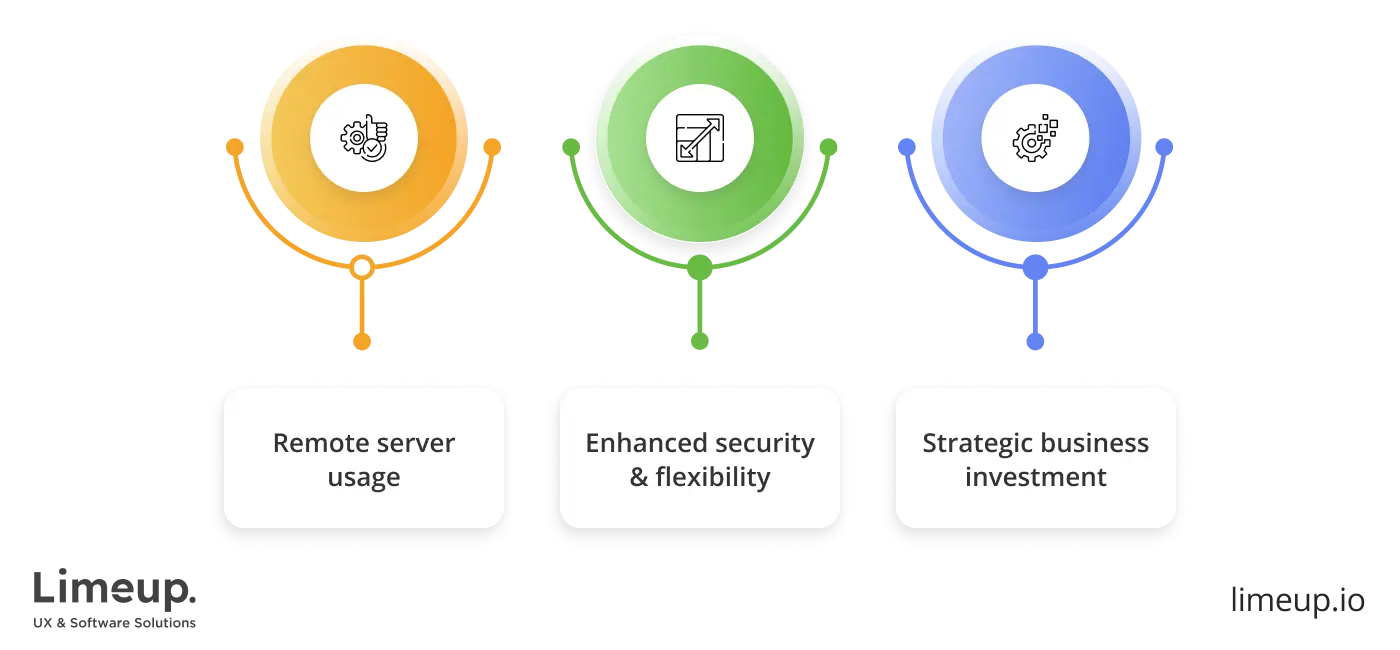
As we have defined the official term, let us refer to the fact that this operation is a significant investment that will define how your firm manages information, and if it can handle ever-evolving needs and growth.
You can dedicate your time to our article about custom application development where our specialists have investigated benefits and types of them in more detail. Therefore, we have considered developing cloud applications in brief and it’s time to dive deeper into the actual process, revealing phases that are somehow hidden in plain sight.
What are the steps for developing cloud applications?
The well-structured process we provide here is the VIP-pass for brands seeking a suitable solution creation as we leverage a decade of experience and over two hundred projects across fintech, healthcare, real estate, education, and other industries.
The report from McKinsey indicated that if a firm optimizes the development, then it’s capable of increasing time to market up to 50%, therefore, we are here with such engineering descriptions. Let’s start with the first stage:
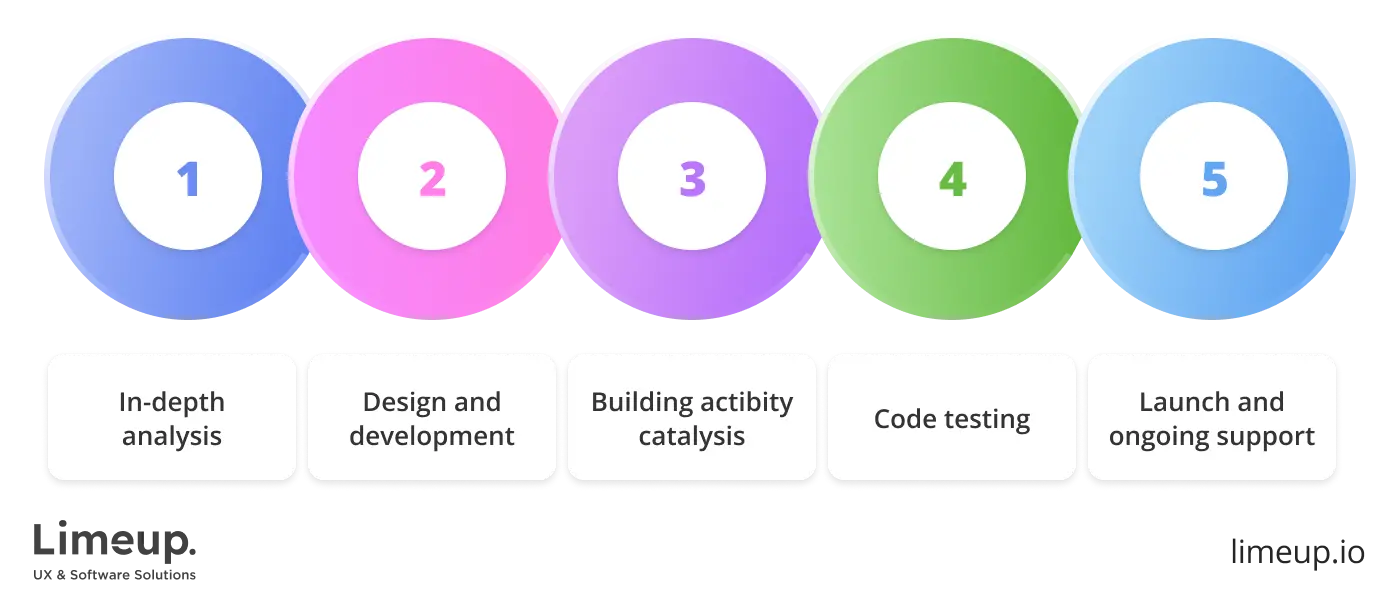
It’s better to know the market you are stepping into if you are a startup and to investigate new trends if you are a hardened business owner, as well as our advice to assess all available data about your competitors to learn about their challenges and successful moments.
As for the niche, cloud-based app development is a promising one, as the whole cloud computing market is predicted to reach an impressive CAGR of 16.5%, which has two sides: more competition and opportunities for growth, that’s why we recommend focusing on needs definition.
This point also includes determining what features you demand, what problems you want to solve with such an application, how it will benefit your operations and scalability, and more. After answering these questions, it’s time to jump right into the second phase.
You definitely know about the Yin and Yang — honestly, too much content about it was created, so designing and deploying have to reach the equilibrium since the first one determines if users will download your app, and the second one if they will stay with you.
It’s advisable to select the model (architecture) we have outlined above (SaaS and others), UI/UX design capabilities and demands like responsiveness and accessibility. As for the actual creation, you have to choose the tech stack for back-end and front-end amidst React, Angular, etc., and decide on testing and ongoing support.
There are two ways: to become a tech guru or hire app developers who know the drill and have related case studies. Both ways are essential to be aware of, for example, core features to be implemented with consideration of security, API integrations, and establishing databases.
Your team of programmers will be coding/developing cloud-based applications and reporting on initial results (if you choose Agile methodology), using the tech stack you selected plus AI technology if you applied for an enterprise-grade solution.
Somehow a few of our customers asked QA to skip this part, thinking about reducing the overall cost, even though they represented the fintech market, which is known for strict regulations. We explained that this stage impacts the overall performance, and downtimes, and fixing bugs now is cheaper than going live and fixing them after complaints and low rates in Play Market or App Store.
Here, the cloud-based mobile app development comes to an end, we wish to say but truly, it doesn’t have a finish line, just like an apartment makeover, since you need to track performance, update security, and adhere to new compliance and growing demands.
Still, it’s the final stage of your project when coders are deploying and your application is going live so that end-users can use it efficiently. Further, maintenance is the way to keep it optimized and up-to-date.
Congratulations as you have come so far in this topic! We have more information to share with you so that you are able to create state-of-the-art products and increase your KPIs.
What are the best practices for cloud app development?
Doing research, our experts concluded that the top-tier ways to implement such a solution are not that widely spread, so they have come across AWS and Microsoft materials, combined with experience from our tech specialists to present you a comprehensive outline of core practices:
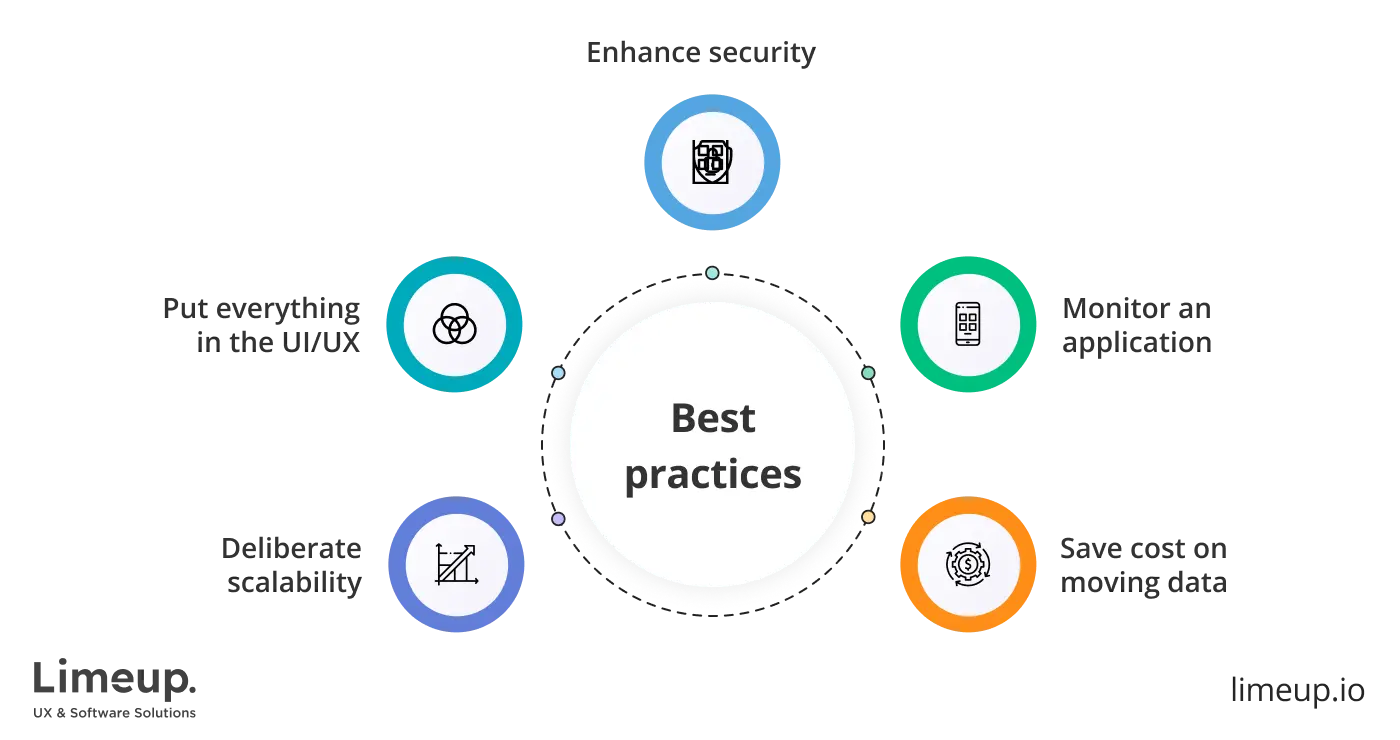
- Deliberate scalability.
As stated by reports, nearly 9 out of 10 end-users abandon apps if they show poor performance, therefore, we have noted a few times that flexibility and leaving space for growth is vital if businesses want to remain competitive and win customers.
Whether you are a fast-growing startup or established brand, cloud mobile app development with the ability to scale up your operations is a golden ticket as you will be able to handle increasing traffic and rapid spikes, for example, when it’s a hustle season, prevent slow loads, and more.
What about the actual moves? — auto-scaling is your best friend, as well as microservice architecture, caching usage, and more robust databases (like NoSQL, which represents MongoDB).
- Put everything in the UI/UX.
Google says that 62% of visitors are less likely to use the services of a company with a bad experience, we, as a provider of cloud application development, regulate customers’ expectations, write down user persona with details about personality, goals, pain points, motivation plus user journey map with core touchpoints and solutions.
On the UI side, keep in mind that you are developing a cloud-based solution that can be accessed from any device, so it’s better to adapt it to various screens. Here, we recommend focusing on user-centricity, clarity of every element, and — again — extensibility.
- Enhance security.
To safeguard every part of your product, it’s advisable to tell you about the practice called “regular audits,” which is implemented by many companies seeking extra information protection. Even a minor detail like insecure coding can impact the whole solution, and yes, the entity takes on security as well, yet, your responsibility includes data storage and management.
Experienced cloud application developers will carry out encryption (symmetric or asymmetric as coders decide), IAM or identity and Access Management, endless monitoring of authorizations, and following governance regulations according to your industry.
As we are talking about hosting online, principles for such an area can’t be ignored, so we recommend following rules that determine the information lifecycle we have considered above.
- Monitor an application.
Powered by Microsoft, this point is about diagnosing the system you build to define triggers and prevent any issues that may lead to downs. With such an approach, bottlenecks will not pass your defense as you will be aware of them even before they appear, as your cloud app development services have the component of resolving any vulnerabilities and issues.
Therefore, there are a few ways to accomplish this practice and enhance your business, first of them stands for automation with AI-powered tools and special software, for example, Google, which we have already mentioned, uses Cloud Monitoring, and you are able to receive yours from a vendor of your choice.
You can include this point in the very first step of planning, determining essential metrics to not get overwhelmed with hundreds of them, as well as a rate for failures that will showcase weak sides.
- Save cost on moving data.
It sounds a little bit like not a practice but we would like to describe this standpoint as we know from our background that sometimes you have to rob the bank to accomplish this process. Custom cloud application development has strategies that work toward reducing spending, such as ensuring there are no duplicates that can increase the price as providers will charge for the amount of data transferred.
To talk more precisely, this method works properly when you delegate the creation process to a vendor, selecting amidst leaders, as represented in our article about top-tier app development companies in the UK. They will take care of every step and ensure to provide a program that suits your needs and budget.
As we have outlined such a daunting moment as premier practices for the building operation and named the ability to hire IT gurus, let’s move on to the intricate topic of choosing a supplier who is capable of taking on the most challenging project and benefitting your brand with a reliable system.
How to select the company to create cloud-based apps?
In order to receive on-demand help with cloud computing, contacting a reliable firm is a winning ticket to robust cloud application development solutions that will be aimed at your unique requirements, as off-the-shelf ones are not the golden opportunities.
We decided to add this theme as many businesses decide to collaborate with a digital pioneer and take this weight off their shoulders, which is logical as they have to dedicate time to urgent tasks that can’t be solved without facing them directly. Therefore, let’s learn how to pick a brand amidst thousands of system integrators available online. Spoiler: you need only 5 considerations.
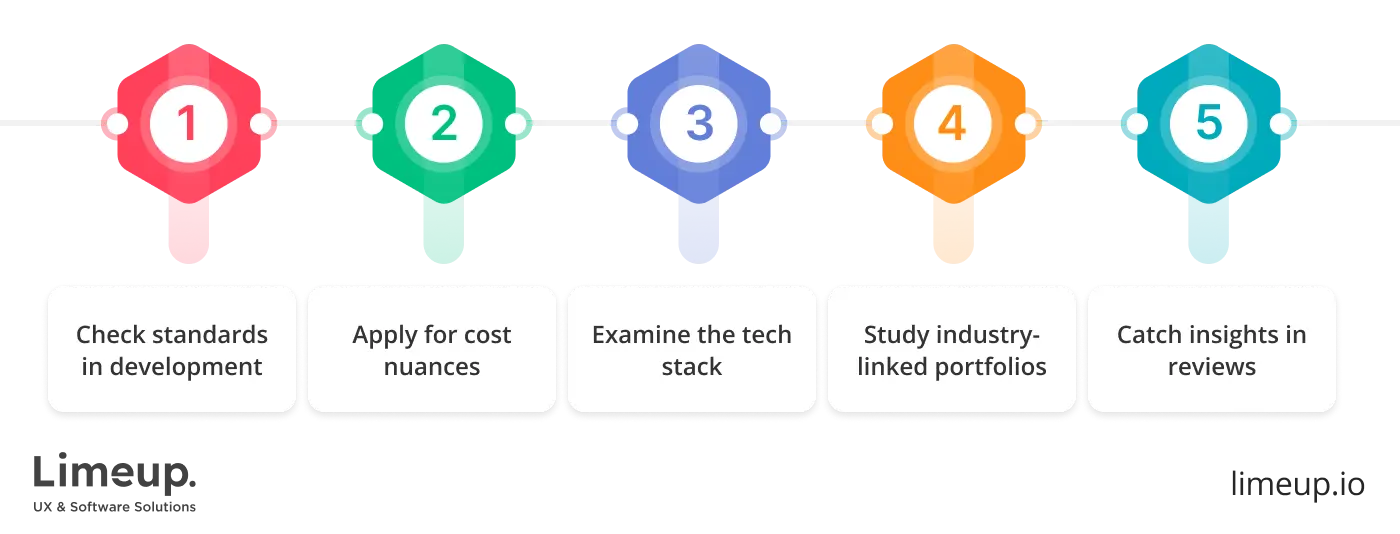
- Check its standards in development.
You may say, “Well, is it really the first thing to examine?” and our answer is yes, according to the importance — not the strict rule — of certifications that are usually posted on the first website’s page so you will not miss them.
Among the most relevant ones are ISO/IEC 27001, ISO 9001 and GDPR Compliance (as we are going worldwide, this is related to Europe), as well as being certified by AWS or Google Cloud. These criteria are about loyalty and confidence, proving that a cloud app development company invests time and money into expanding tech knowledge.
- Apply for cost nuances.
We would like to overview it briefly, as here’s a whole paragraph about the pricing. Therefore, depending on the tech studio, there are rate models like pay-per-project or more known as a fixed fee when you pre-define the amount of cash before diving into the work. Talking about the pros, you are able to predict the final charge and leave it until the end.
Hourly rates are more flexible as you pay for the amount of time spent on your blueprint, yet it’s challenging to predict how much you will spend until the creation is completed. SaaS pricing sounds good for such products as you need to process a monthly or annual fee.
It’s preferable to align the advantages and disadvantages for your business and type of cloud-based mobile application development due to your needs, plus additional fees that can take place in migration and ongoing support so that it will not be a surprise for you.
- Examine the tech stack.
This point comes here at the first time we brought it up since cloud-related building is a complex procedure with many tech activities, so our recommendation is to explore proficiency in back-end and front-end, including HTML and CSS as the foundation, Python and Java, mobile-dedicated Swift and Kotlin (both if you are seeking cross-platform solution).
Since the title says cloud, jousting and infrastructure are included and represented in the knowledge of public+hybrid powers from Microsoft, Amazon, Kubernetes, and others.
- Study industry-linked portfolios.
A cloud application development company with a proven track record will definitely provide all the details, even if the project is under NDA and they can’t spread the customer’s name but still can outline key results, difficulties, programming languages, etc.
We support an approach that includes checking case studies that can be similar to your niche, for example, we have 200+ projects across fintech, education, real estate, and other industries, represented on the corporate website for visitors’ convenience.
We have already noted one of the ways to choose a reliable agency —- using pre-vetted providers from top lists and independent sources where experts investigated success stories and shortlist premier technology houses.
- Catch insights in reviews.
The last but not, you know, least vital are testimonials from previous consumers, posted online in various forms: PDF files with detailed overviews of what was done, videos from CEOs, short informative texts, and more. You are able to contact one of the clients and ask questions about the cooperation with this particular supplier.
Nowadays, outsourcing partners who would like to drive more leads publish all the available information as it impacts the final decision, so finding comments on previous engagements is not a big deal. Note that your goal is to create a cloud application with a confident and skilled collaborator.
Embodying the idea of partnership, you are aware of all the crucial considerations that take place in scrupulous decision-making. You have come a long way here, to the point where all the arms are available, and you need to learn just one more thing — which can feel like a lullaby from the abyss — the price.
We met this concept circumstantially and promised to focus on it lately, so here we go, trying to dissect the specifics behind a tricky question that has no one-all-fit answer. Let’s learn more.
How much do cloud application development services cost?
We will not carry a cat by the tail and say that you can expect to spend thousands of dollars depending on the complexity of your idea as it’s not a daunting task to build a cloud app with fundamental tools but if you are running an organization with hundreds of operations that have to be considered, it will take more time and resources.
Here’s an example of prices that are common for various products:
| Type | Average $ | Description |
| Simple app | $10,000–$49,999 | You receive a basic solution with core yet limited functionality. |
| Medium | $50,000–$149,999 | This point includes more complex features, integrations with databases and APIs, more complicated back-end and custom UI/UX. |
| Advanced | $150,000+ | It’s about large-grade security, governance compliance (especially for fintech), newfangled AI tools, better analytics, and more. |
Such a breakdown is useful but still, our recommendation is to contact a provider and calculate the price with programmers, project managers, and other experts for you to be aware of any surprises. The thing we didn’t mention in the table is the implementation of cutting-edge technologies as they are not rare but still trending, requiring careful assessment.
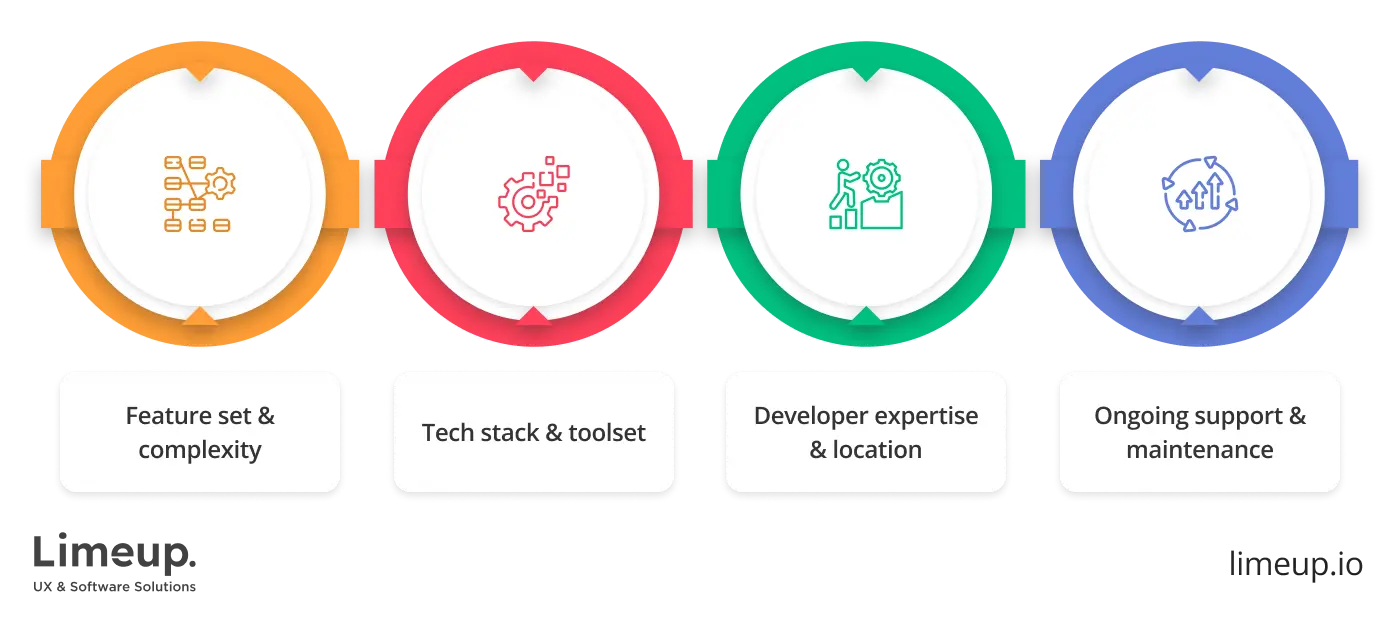
Therefore, your decision to create a cloud app can be affected by the team’s location as well, for example, as outsourcing firms in Asia and Eastern Europe charge less but have their pros and cons, it’s better to refer to the topic of requirements analysis, and then choose a reliable price rate amidst candidates from different regions and countries.
The increase of cloud applications development phenomena in terms of pricing is not a rocket science once you try to solve it, for example, as it’s cheaper if you compare it with the app development cost in a traditional way. There, you can read more about average fees for basic, medium, advanced apps, and eCommerce together with hidden fees from App Store and Play Market, maintenance, and marketing.
In that material we included our experience in reducing the creation price for companies on budget, which are suitable for the cloud as well, if you need a reliable and rich in features application with less spending.
As you received a clear multi-roadmap to your solution’s cost, we can only advise to set up the resources needed, your deadlines, and use the information above to develop a program on your own or in a collaborative way with the IT supplier of your choice.
Summing up
As we have curated the topic of a cloud application development service you are armed enough to start your journey with a reliable team of devs who will bring success to your solution. Our experts boasted their years of background to make this guide, covering core standpoints of determining what stands behind the term and technology, building process, stand-out practices, average prices, and how to choose a proper provider.
For now, all the steps to be conducted plus nuances will seem like a walk in the park since you are aware of pitfalls and know all the details behind creating an app that will be hosted online and enhance your business in multiple ways, from cost reduction to improved productivity.
If you would like to simplify the development by collaborating with a company that has a proven track record, don’t hesitate to contact Limeup. We will leverage cloud computing capabilities to make your business more efficient and help you to remain competitive in the cut-throat markets.

